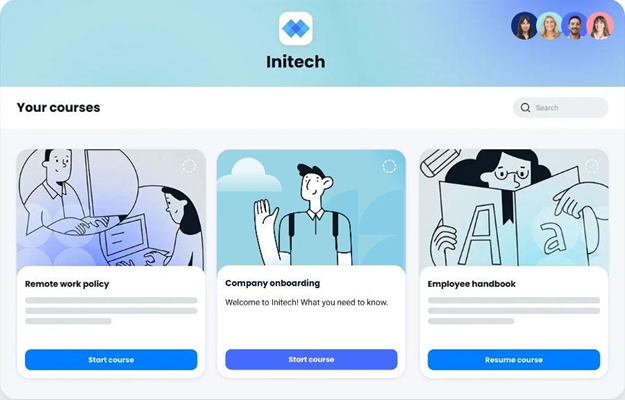Remote work has become mainstream in so many industries. Today, more companies are breaking from traditional working environments to offer remote working options. But just because remote work is on the rise doesn't mean it's easy. A few challenges come along with working outside of a physical office. For example, training your employees can be difficult when they're not in front of you.
Remote training can be just as practical as in-person training if you do it correctly. Zig Ziglar said, "The only thing worse than training employees and losing them is not to train them and keep them." From our research and experience, we have come up with a few tips to help you train your remote employees successfully.
1. Break the information into smaller bites
A lot has been said about people's attention span, especially when consuming content online. Information is a source of learning, but it only becomes a benefit if organized and processed correctly.
When you present information in small chunks, the learner can stay focused on the task and process and retain the information more easily. The trainer can also gauge the trainee's understanding and provide more effective support.
To break information into smaller chunks, you can use short, sharp bursts of information. Give your trainee small pieces of information at a time, and then give them a chance to process it before moving on.
Try not to overload them with too much information at once. You can also structure the information logically. Organize the information into manageable sections, and signpost each section clearly, so your trainee knows what to expect.
Using visual aids can also come in handy. Diagrams, charts, and other visual aids help break down complex information and make it easier to understand.
2. Optimize it for mobile
There has been a significant shift in how people learn in recent years. With the ever-growing popularity of mobile devices and the internet, people are now used to consuming content on the go.
Your employees are not restrained to their desks anymore while working remotely. From a coffee shop to the park, they can be anywhere and still get their work done.
Since 97% of employees want to continue working remotely, you need to consider options like a mobile learning management system (LMS). A mobile LMS is an excellent tool for training remote workers. It allows you to create and deliver courses on the go and provides employees with the flexibility to learn at their own pace. Plus, you can track employee progress with a mobile LMS like Totara Learn, Moodle, and EdApp.
Here are a few tips on how to use LMSs:
- Identify the learning objectives for your training course and design course content around those objectives.
- Break down the material into manageable modules or lessons, including assessment tools to gauge understanding.
- Once your course is complete, upload it to your LMS and launch it for your employees to access.
- Use tracking tools to track their progress. Optimizing mobile learning for your remote employees will make the training process more relaxed and engaging. It also makes it easily accessible.
3. Be goal-oriented
When planning remote training, it is vital to be clear about your goals and objectives. What do you want your employees to learn? What soft skills do you want them to acquire? It is essential to answer these questions before designing a remote training course. Once you understand your goals, you can create remote training that is more focused and effective.
For instance, let's say you want your remote employees to learn how to use new software. If your goal is to ensure that your employees are productive while using the software, you need to create remote training focused on their needs.
Ensure that you plan to teach them how to use the software effectively and efficiently. You can also provide tips and tricks on how to get the most out of the software. It's also important to take care of some tedious yet crucial aspects of employee training, such as compliance training. Employees should know the ins and outs of regulations in their job. For this, they can take advantage of compliance software with employee training and development features.
You state a clear and concise objective by drawing out a good plan. Your remote training will be ineffective without a clear goal, and your employees won't be motivated to complete it.
4. Tap into the latest technology
There are various ways to utilize employee training technologies. But you need to consider the needs of your employees and the type of remote training you are offering to know which technology to use.
For illustration, you can utilize video conferencing tools like Skype or Zoom to offer interactive and hands-on remote training. In addition, consider doing a Zoom / Google Meet comparison to see which works better for your requirements. The usage of these tools have grown significantly, especially with 44% of employees saying that part of their team is full-time remote. These tools allow your remote employees to see, hear, and interact with you in an engaging way. You can also use screen recording to create intricate step-by-step training videos.
Create interactive content presentations using Prezi or PowerPoint. You can upload these presentation slides on remote training platforms like Adobe Connect or WebEx for employees to access anywhere. Later, you can also consider using the iSpring Suite to convert PPT to Scorm and make your training more interactive.

Likewise, you can design remote training courses using eLearning authoring tools like Articulate Storyline or Adobe Captivate. These tools allow you to create engaging and interactive remote training courses that employees can access anytime.
Email is also an excellent way to send training resources to your remote employees. However, ensure that you verify emails to avoid sending resources to invalid addresses or the wrong persons.
Collaboration tools like Google Docs, Trello, etc., can come in handy when you need remote employees to work on a project together.
Technology is your best friend when you are not with your employees. Make use of it to create an engaging and interactive remote training experience. Also, when training the team, make finances professional with a coaching invoice template.
5. Create a mix of self-guided and group training
When you're training employees remotely, it's often more practical to mix self-guided and group training. It will allow employees to learn at their own pace while also providing a sense of community.
Group training helps employees learn from one another, as they can share their experiences and tips. It can also be a great way to build morale and keep employees engaged. You can have employees work on group projects or create study groups, for example. It will help break up the monotony of a single instructor leading the entire remote session.
You do not have to do all the work yourself. Delegate and let employees take charge of their learning.
6. Include on-demand training
Remote work comes with dozens of benefits. Some employees take advantage of the extra time on their hands to launch a lifestyle business and make a bit more money. These employees have an entrepreneurial streak that you can harness by training them to operate a business. Offering them on-demand training will give them the flexibility to accommodate their day job, side hustle, and professional development.

On-demand training allows employees to access the training materials and courses at any time. You can use on-demand training tools like Coassemble and ProProfs to manage your training design process. They exhibit some virtue learning features where trainees can access the content anytime.
They can also replay the sessions as many times as they need to. This type of training is beneficial for employees who have a hard time attending live sessions or who want to review the material at their own pace.
It is also beneficial for companies since they don’t have to worry about coordinating schedules and ensuring everyone can attend the live sessions.
Imagine having to coordinate the schedules of 100 remote employees from different time zones. It would be a nightmare. Thankfully, on-demand training takes care of that problem. It makes remote training flexible and convenient for both employees and the company.
Bottom Line
Training remote employees can be an invaluable investment for any company when done correctly. They can be instrumental to your company’s success.
The training can help create a sense of team spirit and camaraderie among employees even while working from different locations. When everyone is on the same page and working towards the same goal, it can create a strong and productive team.
To properly train your employees remotely, be goal-oriented, tap into the latest technology, and break information into smaller chunks. Include on-demand training and create a mix of self-guided and group training. Also, optimize for mobile.
Follow these tips, and you will create an engaging and interactive remote training experience for your employees. Your remote workforce will be thankful, and the business will reap the benefits of a motivated and well-trained workforce.
About the author:
Owen Baker is a content marketer for Voila Norbert, an online email verification tool. He has spent most of the last decade working online for a range of marketing companies. When he’s not busy writing, you can find him in the kitchen mastering new dishes. Here's his Twitter.
What would you like to know and what would be the best way to share this information with you? What are the best tips & tricks, what workaround do you use? We'd really appreciate your insight on these ones to make our integrations better, more productive, and much more efficient. Comments, tweets are always welcome.